Natural-born Hunters
Cats are natural-born hunters. They need to hunt to feel full-filled. It is good for their mental health, as well as their physical wellbeing. But most folks don’t want to expose their beloved pets to parasites and injuries from live prey, or the dangers of the outdoors. This is where simulated hunts come in.
Simulating Prey
Use a wand toy to simulate prey. Or tie a toy or small item to a string. Then move it as if it were prey. Erratically, like a bug or mouse would move. Crawling along a wall, then dashing across an open area to rest under the coffee table. Peeking in and out of a corner. And as you do this, look at the toy, NOT the cat. Cats will follow your gaze. You don’t want the cat staring at you, so don’t stare at him.
Of course, you do have to glance to see if he is following the toy with his eyes. If he is, you are doing a good job. If he isn’t watching, you can have the toy approach him at a diagonal, not directly. Remember, you are simulating a prey animal. Coming directly at him is more like a predator or aggressor. We aren’t training them to fight, but rather to hunt. Hunting successfully will boost their confidence, which is relaxing. Fighting off an attacker is stressful.
The Hunting Sequence
We want to see the hunting sequence. Watch, butt wiggle, pounce! Some cats wait to pounce until the toy is still, or just quivering slightly. Others spring to action when a resting toy pulls away. You will learn what entices your cat to pounce.
Play at Least Daily
Most cats need daily simulated hunts. If you have more than one cat, let them hunt individually. If your cat is one to attack feet, then she needs more hunts. And remember to let her win. She needs to eventually catch that toy. Then let her chew it or carry it around if she wishes. But put it away when she’s done. String is dangerous for a cat. And a wand toy laying out all the time is less believable when it “comes to life” than a toy that is only seen “alive”.
For active cats, you might want to have another wand toy on a top shelf or on the window sash, or a toy tied to a string placed in your pocket. When the cat catches the first toy, and you have dropped it to let her play with it on her own, walk across the room. When her play slows, bring out the next toy, and pretend that it is a bug or a mouse.
For less playful cats, one short hunt may be enough. Let this type of cat catch it as soon as, or soon after, the first time they bat it. For these cats, a very small item tied to the end of the string is best. And the Cat Dancer may suit them well.
Patience Fisher owns Patience for Cats LLC, a cat behavior business based in Pittsburgh, PA. She is Certified by the International Association of Animal Behavior Consultants. She holds a Bachelor’s in Biology, a Diploma of Feline Behavior Science Technology, and is a certified veterinary assistant.

